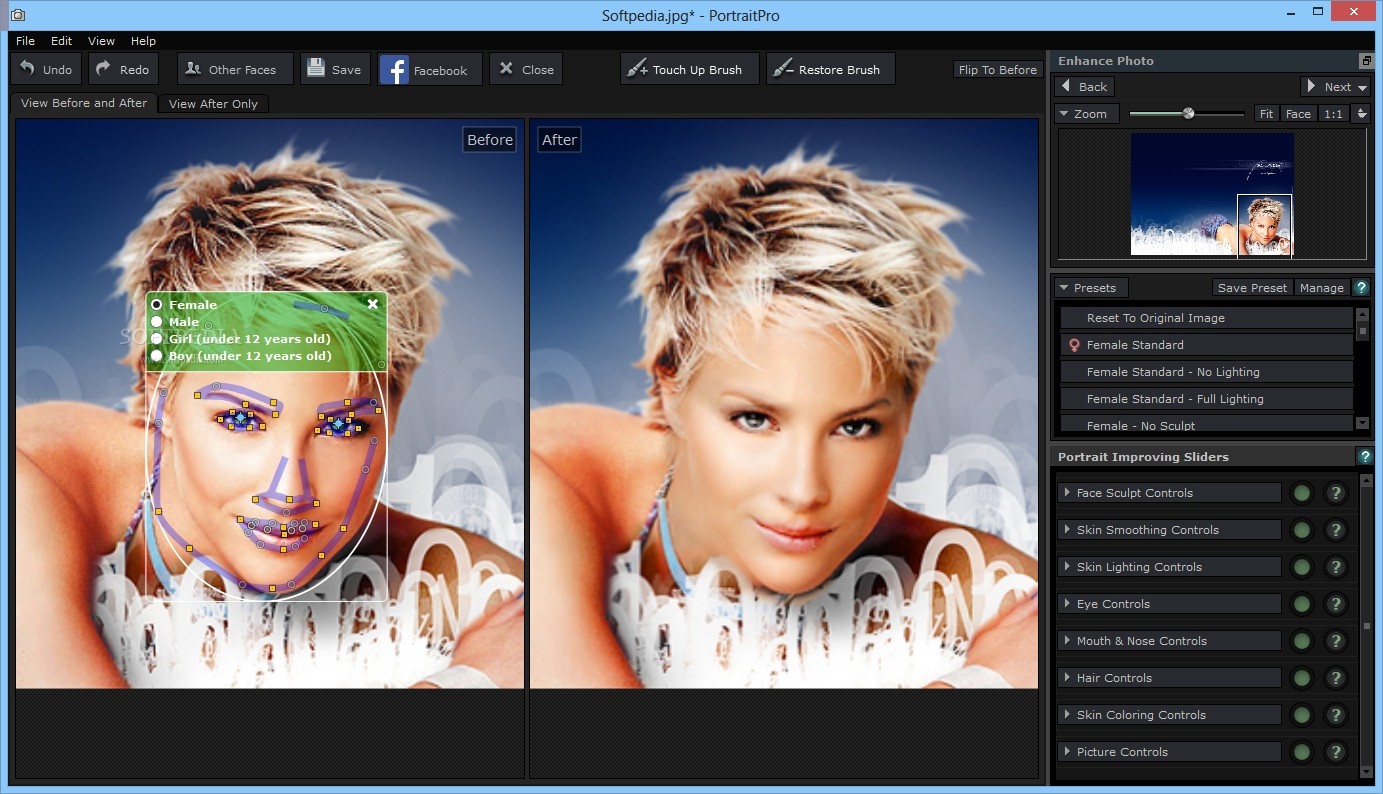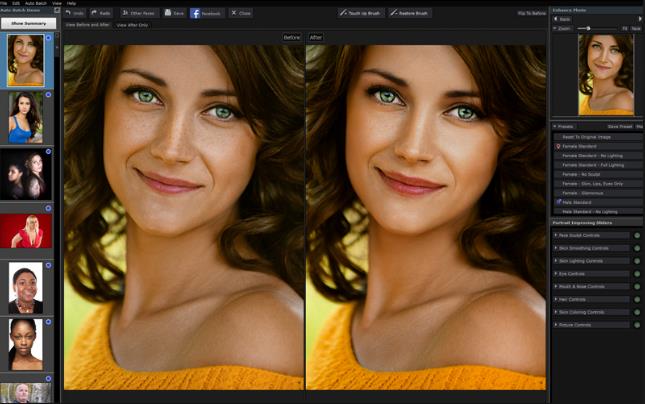Portraitpro Studio Max Full
While many of us would rather outsource image retouching, it’s an exchange of creative control for greater time efficiency. PortraitPro 18 is an alternative, which is what initially drew me to Anthropic’s PortraitPro Studio Max several years ago when I reviewed version 15. Complete control: check. Improved efficiency: check. The original images shown in this review are straight from the camera, and retouches have been made solely with PortraitPro.
The PortraitPro 18 Studio Max installer prompts you regarding plugins for Adobe Photoshop and Lightroom. For easy access to PortraitPro from those programs, install the plugins. Once installation is complete, you can open PortraitPro directly or via Photoshop (Filter > Anthropics > PortraitPro…). In Lightroom you must set up an additional external editor (Edit > Preferences > External Editing) by navigating to the PortraitPro application file. Then you can right-click any image and access PortraitPro (Edit in > Edit in PortraitPro…).
PortraitPro Studio Max was reviewed by Giorgiana Arghire. New in PortraitPro Studio Max 17.1.3. Read the full changelog. DOWNLOAD PortraitPro Studio Max 21.4.2 for Windows. PortraitPro Studio Max is the top level edition of PortraitPro with a full Batch Mode for processing multiple images. It can run standalone or as a plugin, and has support for RAW files and color profiles. PortraitPro Studio Max—which I am using for this review, both as a standalone and a Photoshop plugin—includes all of the features in the Studio edition, plus fully automated batch processing for professionals with large numbers of files to correct. MSRP of PortraitPro Studio Max is $169.95.
© Betsy FinnTo see the extent of PortraitPro 18 editing potential, compare the original image (top left) to the one with a background added (top right), makeup added (bottom left), and facial sculpting (bottom right), which is best left for instances where the client requests it.
Upon opening an image, PortraitPro automatically detects faces and attempts to determine age and gender (adult male, adult female, child), but you can override mistakes. On the right side of the screen is a menu toolbar full of sliders and selections—skin lightening, skin masks, eyes, makeup—you name it, PortraitPro pretty much has it covered. There’s even a retouching brush you can use to paint over blemishes that escaped the first round of auto retouching and a restore brush that can remove retouching. Version 18 also allows you to completely mask all edits in an area.
While PortraitPro is good for editing individual images, where it really shines is in batch mode. You can select a folder of images (I use the Windows dialog menu to search for just the TIF files I’ve created in a given folder), and PortraitPro will grind away at recognizing facial features and applying retouching presets to each one. At this point, the extent of PortraitPro’s efficiency is up to you. Either close out the auto batch immediately or tweak individual images as desired.
PortraitPro takes retouching to the next level, or maybe even beyond. The default retouching preset is too heavy-handed for my style, particularly with facial sculpting. Fortunately, there’s an easy fix: custom presets. I created my own preset with a natural, authentic look that matches my own style.
Compared to its predecessor, PortraitPro 18 has faster and more accurate facial recognition (with more draggable points), an improved restore brush, better background masking, options for layers such as a logo or other overlay on top of the image, and more. There are also improvements to hair, skin, and eye controls, including an “open/closed” eyes feature.

My favorite upgrade is the ability to enable non-destructive editing with smart filters in Photoshop (Filter > Convert for Smart Filters). When you run PortraitPro and return to Photoshop, a Smart Filter layer is created that you can toggle off or use to tweak later edits. This is a big improvement over the last version I tested, which required starting from scratch in PortraitPro if you wanted to change your retouching after running the Photoshop plugin.
© Betsy FinnPortraitPro 18 works extremely well for smoothing skin tone and opening eyes just a bit wider. Compare the original capture (top photo) to the edited version (bottom photo).
I’ll preface my conclusion by saying that I don’t expect anyone to use all the features in this software for everyday retouching. But, should you ever need it, it’s nice to know that PortraitPro has covered all the bases as far as makeup, hair, skin, and backgrounds.
Is there anything PortraitPro can’t do? I encountered one situation where my subject was in profile view with her eyes closed. While the “eyes closed” buttons worked nicely in other situations, I didn’t see an option for “eyes off” in that specific situation.

Beyond that, I have a couple things I’d love to see in future versions: the ability to run a batch edit from a selection of Lightroom images, the ability to export PortraitPro’s background mask to Photoshop, and flexibility in the TIFF file extension. Why the last one? It’s more of a workaround for the lack of batch editing from Lightroom. I’ve been exporting TIF files from Lightroom, batch editing them in PortraitPro, and then renaming the generated TIFF files to TIF so that Lightroom recognizes the edited files. TIF and TIFF are, practically speaking, the same extension. Adobe generates TIF files, PortraitPro uses the newer convention TIFF files.
Nagini 2 serial telugu lo. Overall, PortraitPro is a delight to use, even though my retouching style doesn’t warrant taking full advantage of all its retouching features. If you’re looking to improve your retouching workflow efficiency but don’t want to outsource or worry about losing creative control, give batch mode a shot. It may be a game changer for you.
PortraitPro comes in three versions: Standard ($44.95), Studio ($69.95), and Studio Max ($139.95). The Standard version is limited to JPG and 24-bit TIFF files, lacks batch editing, and does not integrate with editing software. The Studio version lets you work with raw or 48-bit files and has a basic batch dialog. Studio Max has full batch mode for the greatest efficiency. Both Studio and Studio Max integrate with Photoshop, Lightroom, and Aperture. A free trial is available at portraitprofessional.com.
Betsy Finn is a portrait artist in Dexter, Michigan.
Tags: post captureretouchingtechniqueRelated
 Quick Takes
Quick TakesOn Cloud Nine
For Lan Nguyen, daydreaming pays off.
Time-Saving Solution Makes Retouching Intuitive and Enjoyable
Review by Jessica Maldonado
Portraitpro Studio Max 18 Full
It’s been my pleasure to review PortraitPro for Photoshop User in the past, and every year Anthropics manages to add new features that are certain to make photographers and designers who use the software giddy with nerdy pleasure. PortraitPro 18 doesn’t disappoint: It builds thoughtfully upon its already substantial base with several upgrades this time around. I’ll cover all the best improvements in this review, but refer to my reviews in the December 2017 and February 2016 issues for in-depth descriptions of the fantastic retouching capabilities of this thoroughly enjoyable-to-use, valuable tool.
There are three versions of PortraitPro 18—Standard, Studio, and Studio Max (reviewed here). Rather than going top-down, I’ll jump to the addition I was immediately excited to use: Smart Filter capability (available in the Studio editions only) when used as a Photoshop plug-in. You could already save your PortraitPro sessions in the standalone application (already pretty nifty); to be able to open your smart object from Photoshop, quickly retouch it in PortraitPro, and pop it back into Photoshop (keeping the option to make additional/new edits), working around that layer nondestructively, is a truly valuable feature—particularly, for designers and compositors. I have one nitpick: If you want to toggle the Smart Filter off and on, it opens the plug-in again. So, maybe just hide that layer in Photoshop and look at your original instead. (You do work on a duplicate of your background, don’t you? You should! 😉 ).
A much-requested feature now in PortraitPro 18 is Eye Controls. With the click of a button, you can easily compensate for a closed or hidden eye, as well as control the edits for each eye separately.

The new Restore Brush lets you remove edits where they’d interfere with non-facial portions of the image (e.g., something that’s covering part of the face). Oddly, using the Restore Brush directly on your image doesn’t employ the Effects Mask, and so isn’t editable; first, you must click the button within the tool’s pop-up to bring up the View/Edit Effects Mask section. If you use the Restore Brush on the mask itself, an errant stroke won’t ruin your retouch.
Portraitpro 17
The already mind-blowing facial recognition algorithms of PortraitPro have been reworked under the hood to save users even more time (less tinkering with the selection/outline nodes), and provide better background masking. To accompany improvements to the background masking features, there’s now a Layers menu, where you can add overlays and change the layer order. This is a great addition for photographers to include watermarks or logos on their images, or for non-Photoshop lovers to play with frames or double exposures. There’s even a folder of defaults with which to experiment.
Portraitpro Studio Max 17 Full
Feature-, Skin-, and Hair-finding technology have all been enhanced for better accuracy. Hair controls now include a plumping feature (Hair Shape slider). It’s a great idea, but one of those things for which you need the perfect image, or it will create strange results. I’m all for keeping this slider, though, and I’m willing to bet that next time it will be smarter!
Be sure to download your free trial to experience how fast and fun retouching can be. Many projects or clients require (and pay for) painstaking hours or days of meticulous retouching, using the pro skills we teach at KelbyOne. Acdsee mac pro 3 serial. Pressed-for-time photographers with jobs requiring quick turnaround, reduced budget, or batch processing will appreciate all that PortraitPro 18 has to offer. ■
